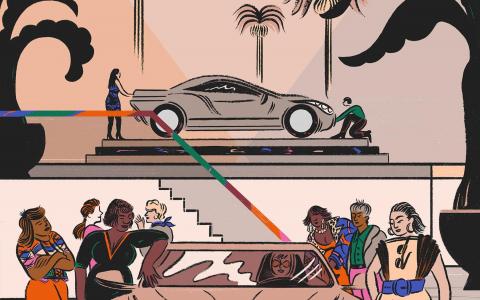
Until recently, the long-wheelbase Rolls-Royce Phantom was the perfect car for a woman of means in Saudi Arabia.
At 20 feet long, it appealed to those who, in accordance with Shariah law, preferred to remain distant from their male driver. But now that Saudi women will be able to legally operate vehicles, as of June 24, 2018, smart observers expect the 3-ton $450,000 V-12 coach to be overtaken in popularity by something rather more fun, such as the sporty two-door Rolls-Royce Wraith.
“Now it’s personal,” says Rebecca Lindland, an executive analyst at Kelley Blue Book Co. who lived in Saudi Arabia for two years to study car-buying habits. “Before, those cars had a practical purpose. Now, with women driving, I can see them definitely showing so much more personality through their purchases.”
The luxury car market for women in Saudi Arabia has tremendous potential, Lindland says. “This is something these women have fought for for decades,” she says.
“They cannot wait.” And the new law, announced by royal decree last September, will have deep effects on the car business there. TV commercials and print editorials marketing cars to women appeared overnight.
As hard-won as this victory was, it coincides with a natural swell in attention that luxury automakers are paying to wealthy female buyers worldwide. Automobili Lamborghini SpA recently produced its first fully modern SUV; Ferrari NV and Aston Martin Lagonda Ltd. will soon do the same. According to IHS Markit, women buy more compact and midsize luxury SUVs—the single largest growth market among luxury brands—than any other vehicle type.
“Women are driving the CUV [crossover utility vehicle] revolution among luxury brands,” says Marc Bland, a vice president for diversity and inclusion at IHS Markit. “They have made luxury SUVs better sellers than luxury sedans ever since Lexus introduced the midsize RX in 1998.”
Since at least 2015, Aston Martin Chief Executive Officer Andy Palmer has said he views women as a way to increase the brand’s dwindling sales. As of that year, Aston had sold fewer than 70,000 vehicles in its century-long history.
Last year, Aston created a female advisory panel to review current and future products and give feedback to shape vehicles. A hypothetical customer named Charlotte—a “wealthy and attractive American woman in her late 30s”—is the target audience for cars like the peppy 2017 DB11 Volante convertible, priced at $216,495. The marque is targeting a valuation of as much as £5 billion ($6.9 billion) in a potential initial public offering, according to Bloomberg News. Investors will have an eye on Aston’s planned expansion into the SUV segment, starting in 2019.
Meanwhile, in 2015, McLaren Automotive Ltd. developed a sport series specifically to appeal to “a broader range of drivers.”
The line has doubled company sales.
Dealers are responding to a shift in interest, too.
“I have noticed quite a significant uptick in the amount of women who come in to buy something special,” says Brett David, the 30-year-old owner of a Miami Lamborghini dealership, Prestige Imports. He’s building a marketing plan for the Lamborghini Urus and expects female shoppers to play a large role.
“There is a new demographic,” he says. Lamborghini has also aggressively extended its financing options to lure buyers across the board.
In this way, top-tier brands are following the trend of the middle-priced automakers, such as BMW, Mercedes-Benz, and Audi, which have made billions on SUVs they sell to families. In the past three years, European brands Jaguar, Alfa Romeo, and Maserati have followed with utility vehicles—and subtle marketing efforts—of their own.
A recent Super Bowl ad for Alfa Romeo’s Giulia was narrated by a woman; a 2017 holiday promo for the Infiniti Q50 featured a woman grabbing the keys from her husband and fleeing the kitchen for an excuse to drive.
But automakers haven’t always done well when they’ve tried to connect with women. From the Dodge La Femme in the 1950s—it came with lipstick, a “stunning shoulder bag in soft rose leather,” and abysmal sales—to the Cadillac SRX, which was marketed with an ad featuring dorky dads drooling over a mom at school drop-off, overtures have oftentimes been embarrassing. Even the first push for electric automobiles more than 100 years ago failed after the vehicles were marketed as “ladies’ cars.”
The line between engaging and patronizing is a fine one—as recently as July 2017, Audi had to apologize for an ad it ran in China where a future mother-in-law inspected a bride like she would a used car.
“It would be so ignorant to identify the buyer of a car today based on paint color or trim preference,” says Prestige Imports’ David. “That’s ridiculous. It’s not about whether there is a hole in the back seat for a purse. It’s about a new experience. Women want a car that means something.”



